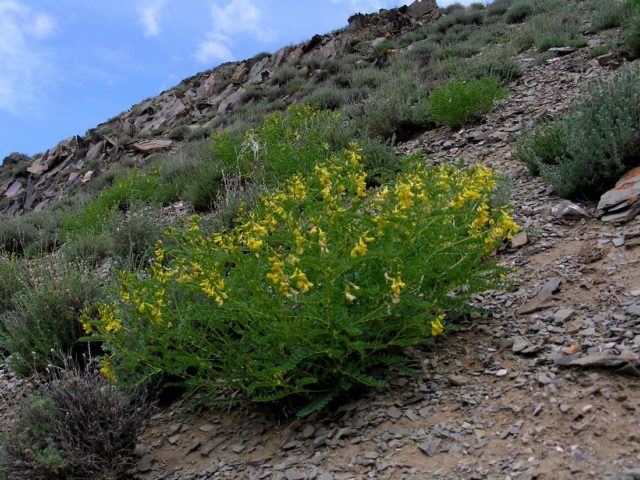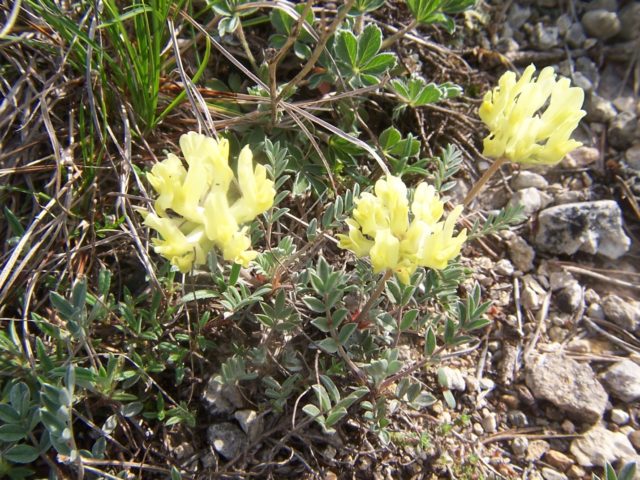Content
Traditional medicine still successfully “withstands competition” from the pharmaceutical industry. Many of the plants and herbs used have been known to mankind for a very long time, their effectiveness has been tested and proven by time. This group includes densely branched astragalus. The health benefits of the plant are also recognized by official medicine, including it as an ingredient in some of the dietary supplements sold in pharmacies.
What it looks like and where it grows
Densely branched astragalus is a shrub from the legume family. The plant is endemic, its distribution area is limited to Turkmenistan and Iran (mountainous regions of the eastern and central Kopetdag). From soils, it prefers slopes and taluses covered with stones, rubble, on which other plants rarely take root. The optimum altitude is 1000-1400 m above sea level. Astragalus densely branched in folk medicine of different countries is known under many nicknames - "yellow root", "royal grass", "cat peas", "centaury".

Astragalus densely branched grows in a very limited area
The size of the densely branched Astragalus shrub does not differ, reaching about 1 m in height. Shoots straight or ascending, intensively branching closer to the apex. Because of this, the crown seems loose. The internodes are developed, rather short. The branches are densely covered with long (3-3.5 cm) sharp thorns, bent almost to the horizontal. The root is very powerful, pivotal, practically does not branch. It is he who is most often used in traditional medicine.
The leaves of the plant are paired-pinnate, with pointed, even prickly tips. Each consists of 6-10 pairs of small leaves. They are located alternately. The petioles are also covered with thorns, gradually lignify, remain on the branches when the foliage of the plant falls off.
Flowers of Astragalus are densely branched axillary, collected in two, dotted with annual shoots throughout their length. The petals are pale yellow, with purple veins. Diameter - 5-7 mm. Flowering occurs in June-July. The fruits ripen in August-September. Pods are ovoid, densely edged, small (about 4 cm long). Each has one seed. Even when they are fully ripe, the beans on the plant do not burst.

By the shape of the leaves, it is easy to understand that the densely branched astragalus belongs to the legume family
The healing properties of Astragalus densely branched were well known to the ancient Greeks, Arabs and Scythians. In the latter, the plant was generally considered "the herb of immortality", intended exclusively for the needs of the nobility. Women and children were forbidden to use formulations of astragalus densely branched on pain of death.
Chemical composition
The use of densely branched astragalus in folk medicine is due to the richness of the chemical composition of the plant:
- vegetable mucus bassorin and arabin;
- terpene saponins;
- flavonoids quercetin, kempfenol, isorhamnetin (polyphenols of natural origin, the effectiveness of which in the prevention of cancer has been scientifically proven);
- organic acids (are involved in almost all metabolic processes in the body);
- polysaccharides (a valuable source of energy for humans, in particular for metabolism);
- tannins (a natural antiseptic that helps to remove pathogenic microflora and toxins from the body);
- essential oils (have antibacterial properties);
- alkaloids (natural analgesic, mild sedative effect);
- coumarins and phytosterols (synthesized by densely branched astragalus independently, have a beneficial effect on immunity, reduce blood cholesterol levels);
- vitamins (A, B9, C, E);
- steroids (biologically active substances);
- macro- and microelements (phosphorus, calcium, magnesium, iron, manganese, sodium, silicon, less often selenium, gold, molybdenum, barium).

Means according to recipes of traditional medicine based on astragalus densely branched have a wide spectrum of action
Healing properties
The healing properties of Astragalus densely branched are quite versatile. This plant is used in folk medicine for the following purposes:
- strengthening the cardiovascular system, cleaning blood vessels;
- activation of the kidneys and excretory system (acts as a diuretic);
- normalization of high blood pressure;
- fight against excessive excitability, emotional swings, insomnia;
- treatment of migraines, dizziness attacks;
- increasing the tone of the body, restoring strength and improving immunity;
- dilution of phlegm in the bronchi and lungs.
Astragalus densely branched contains polysaccharides in a fairly high concentration. But this does not mean that it is forbidden to use it prepared according to the recipes of traditional medicine from it for diabetes of any type and the presence of excess weight. On the contrary, they normalize blood composition, lower glucose levels, and activate metabolism, which is very useful for those who want to lose weight.
Medical applications and recipes
Traditional medicine offers the following options for using astragalus root densely branched in different cases:
- With a general decline in vitality. A teaspoon of crushed raw materials is poured into 200 ml of boiling water, kept in a water bath for an hour. After that, the liquid is filtered, warm water is added, restoring the original volume. The remedy is taken in 2 tbsp. l. before every meal.
- With angina. 2 tbsp. l. crushed roots of astragalus densely branched are poured with 100 ml of water, after half an hour they are heated over low heat to a boil. After waiting 5 minutes, remove from the stove, let it brew for 4-5 hours. Before use, filter the finished product, drink it three times a day, during meals, 2 tbsp. l.
- With tonsillitis. Mix about 1 tsp. crushed roots of astragalus densely branched, dry coltsfoot, chamomile, lime blossom, thyme, sage, eucalyptus leaves. 1 tbsp. l. this collection is poured with a glass of hot water, boiled. Drink immediately, without letting it cool too much, a glass 3-4 times a day.
- For insomnia. 2 tbsp. l. chopped astragalus root densely branched pour a glass of boiling water, leave to infuse for 40 minutes. About 2 hours before bedtime, half a glass is drunk, after another hour - the remainder (with sediment). The course of treatment lasts 2 weeks.
- With bronchitis, phlegm in the lungs. Astragalus, marshmallow and licorice roots, fennel fruits, coltsfoot leaves are taken in approximately equal proportions. 1 tbsp. l. the collection is poured with a glass of cold water, after 2 hours it is boiled for 5-7 minutes. Filter the finished broth, drink it a day, dividing the total volume into 3-4 servings.
- With neurosis. 2 tbsp. l. the roots of astragalus densely branched are poured with a liter of boiling water, heated for 10 minutes. Immediately poured into a thermos, let it brew overnight. In the morning, filter the broth, drink it 2-3 times a day, half a glass, about half an hour before meals. The maximum duration of admission is 3 weeks.
- With age-related weakness. About 100 g of fresh crushed roots of Astragalus densely branched are poured with a liter of dry red wine or 400 ml of vodka. Insist for 2-3 weeks in a dark cool place, shaking the container occasionally. Filter the finished tincture, take 30-40 or 10-15 drops, respectively, twice a day, half an hour before meals.
The most complex positive effect on the body is exerted by tea from astragalus densely branched with ginseng, sweetened with honey. You need to take 1 tsp.chopped roots, pour 0.5 liters of boiling water, strain after 30 minutes. This is the daily norm, it is divided into 2-3 servings. Drink 15-20 minutes before meals.
Contraindications
There are few contraindications for taking funds from the arsenal of traditional medicine based on astragalus densely branched:
- Hypotension (low blood pressure) and increased blood clotting.
- The entire period of pregnancy and lactation. There have been no scientific studies on the effects of densely branched astragalus on the body of the mother and fetus.
- Individual intolerance. An allergic reaction can never be ruled out. To test, some of the finished product is applied to the crease of the elbow or the inside of the wrist. For the appearance of itching, burning, redness, rash, edema, 20-30 minutes is enough.
Collection and procurement
In ancient times, in folk medicine, astragalus gum was most often used. Now it is in demand mainly by the pharmaceutical industry, but only white gum is used there. It is used as a "binder" in tablets and emulsions.
They get it by simply cutting the shoots of Astragalus densely branched before flowering. Under pressure, a thick, whitish mass immediately begins to stand out on the surface. After waiting 5-6 days for the gum to dry, it is collected by simply scraping it off the plant. In this case, the color may change to yellowish or brown, then the substance is considered "technical". The collected gum is dried to a powdery state (the so-called tragacanth).
Now traditional medicine uses the roots of astragalus densely branched. The best time to harvest them is early autumn. A "donor" can be a plant at the age of 3-4 years. The roots extracted from the ground are thoroughly washed, dried in a natural way.

The roots of Astragalus densely branched are harvested by digging in only adult plants
Conclusion
Astragalus densely branched - a medicinal plant, to the help of which people have resorted to since antiquity. A wide range of effects determines its demand in traditional medicine. Scientific studies of the chemical composition also confirm the benefits. There are not so many contraindications for taking decoctions and other folk remedies based on astragalus densely branched, but you should first consult with a specialist and check for individual intolerance.








